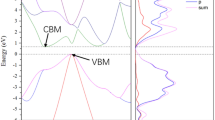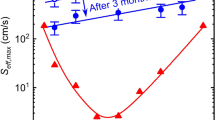Abstract
High-purity germanium (HPGe) detectors, which are used for direct dark matter detection, have the advantages of a low threshold and excellent energy resolution. The surface passivation of HPGe has become crucial for achieving an extremely low energy threshold. In this study, first-principles simulations, passivation film preparation, and metal oxide semiconductor (MOS) capacitor characterization were combined to study surface passivation. Theoretical calculations of the energy band structure of the –H,–OH, and –NH2 passivation groups on the surface of Ge were performed, and the interface state density and potential with five different passivation groups with N/O atomic ratios were accurately analyzed to obtain a stable surface state. Based on the theoretical calculation results, the surface passivation layers of the Ge2ON2 film were prepared via magnetron sputtering in accordance with the optimum atomic ratio structure. The microstructure, C-V, and I-V electrical properties of the layers, and the passivation effect of the Al/Ge2ON2/Ge MOS were characterized to test the interface state density. The mean interface state density obtained by the Terman method was 8.4 × 1011 cm−2 eV−1. The processing of germanium oxynitrogen passivation films is expected to be used in direct dark matter detection of the HPGe detector surface passivation technology to reduce the detector leakage currents.









Similar content being viewed by others
Data availability
The data that support the findings of this study are openly available in Science Data Bank at https://cstr.cn/31253.11.sciencedb.14917 and https://doi.org/10.57760/sciencedb.14917.
References
A. Boeltzig, A. Best, G. Imbriani et al., Improved background suppression for radiative capture reactions at LUNA with HPGe and BGO detectors. J. Phys. G Nucl. Part Phys. 45, 025203 (2018). https://doi.org/10.1088/1361-6471/aaa163
Y.L. Dang, F.L. Liu, G.Y. Fu et al., New measurement of thick target yield for narrow resonance at Ex = 9.17 MeV in the 13C(p, γ)14N reaction. Chin. Phys. B 28, 060706 (2019). https://doi.org/10.1088/1674-1056/28/6/060706
D.M. Mei, Z.B. Yin, S.R. Elliott, Cosmogenic production as a background in searching for rare physics processes. Astropart. Phys. 31, 417–420 (2009). https://doi.org/10.1016/j.astropartphys.2009.04.004
A. Déjeant, L. Bourva, R. Sia et al., Field analyses of 238U and 226Ra in two uranium mill tailings piles from Niger using portable HPGe detector. J. Environ. Radioact. 137, 105–112 (2014). https://doi.org/10.1016/j.jenvrad.2014.06.012
M.U. Khandaker, P.J. Jojo, H.A. Kassim et al., Radiometric analysis of construction materials using HPGe gamma-ray spectrometry. Radiat. Prot. Dosim. 152, 33–37 (2012). https://doi.org/10.1093/rpd/ncs145
G. Xhixha, M. Alberi, M. Baldoncini et al., Calibration of HPGe detectors using certified reference materials of natural origin. J. Radioanal. Nucl. Chem. 307, 1507–1517 (2016). https://doi.org/10.1007/s10967-015-4360-6
F. Tuo, C.H. Xu, J. Zhang et al., Radioactivity analysis following the Fukushima Dai-ichi nuclear accident. Appl. Radiat. Isot. 78, 77–81 (2013). https://doi.org/10.1016/j.apradiso.2013.04.002
S. Feng, R. Liu, X.X. Lu et al., A study of 239Pu production rate in a water cooled natural uranium blanket mock-up of a fusion-fission hybrid reactor. Nucl. Fusion 56, 036019 (2016). https://doi.org/10.1088/0029-5515/56/3/036019
J. Zhu, H. Li, T. Xue et al., Prototype of pulse digitizer and readout electronics for CDEX-10 in CJPL. J. Inst. 15, T01002 (2020). https://doi.org/10.1088/1748-0221/15/01/T01002
Z.Y. Zhang, L.T. Yang, Q. Yue et al., Constraints on Sub-GeV Dark Matter-Electron Scattering from the CDEX-10 Experiment. Phys. Rev. Lett. 129, 221301 (2022). https://doi.org/10.1103/PhysRevLett.129.221301
Z. Liu, Q. Yue, L. Yang et al., Constraints on spin-independent nucleus scattering with sub-GeV weakly interacting massive particle dark matter from the CDEX-1B experiment at the China **** underground laboratory. Phys. Rev. Lett. 123, 161301 (2019). https://doi.org/10.1103/PhysRevLett.123.161301
Z.F. Lu, Y.L. Li, J. Li et al., MSE/SSE discrimination methods of the PC-HPGe detector. Chin. Phys. C 36, 855–860 (2012). https://doi.org/10.1088/1674-1137/36/9/011
Y.Y. Liu, J.P. Cheng, P. Pang et al., Develo** cold-resistant high-adhesive electronic substrate for WIMPs detectors at CDEX. Chin. Phys. B 29, 045203 (2020). https://doi.org/10.1088/1674-1056/ab718a
L. Zhang, C.K. Qiao, J.J. Zhu et al., Preparation of large volume solid argon crystal and its feasibility test as a scintillation material. Crystals 12, 1416 (2022). https://doi.org/10.3390/cryst12101416
Y. Wang, Z. Zeng, Q. Yue et al., First experimental constraints on WIMP couplings in the effective field theory framework from CDEX. Sci. China Phys. Mech. 64, 281011 (2021). https://doi.org/10.1007/s11433-020-1666-8
C.E. Aalseth, P.S. Barbeau, N.S. Bowden et al., Results from a search for light-mass dark matter with a p-type point contact germanium detector. Phys. Rev. Lett. 106, 131301 (2011). https://doi.org/10.1103/PhysRevLett.106.131301
E. Armengaud, C. Augier, A. Benoît et al., Searching for low-mass dark matter particles with a massive Ge bolometer operated above ground. Phys. Rev. D 99, 082003 (2019). https://doi.org/10.1103/PhysRevD.99.082003
M. Agostini, G. Araujo, A. Bakalyarov et al., Final results of GERDA on the search for neutrinoless double-β decay. Phys. Rev. Lett. 125, 252502 (2020). https://doi.org/10.1103/PhysRevLett.125.252502
C.E. Aalseth, N. Abgrall, E. Aguayo et al., Search for neutrinoless double-β decay in Ge-76 with the majorana demonstrator. Phys. Rev. Lett. 120, 132502 (2018). https://doi.org/10.1103/PhysRevLett.120.132502
R. Agnese, T. Aramaki, I.J. Arnquist et al., Results from the super cryogenic dark matter search experiment at Soudan. Phys. Rev. Lett. 120, 061802 (2018). https://doi.org/10.1103/PhysRevLett.120.061802
G. Gelmini, P. Gondolo, DM production mechanisms. ar**v preprint ar**v:1009.3690 (2010)
M. Balata, N. Marco, M. Junker et al., Characterization of inverted coaxial 76 Ge detectors in GERDA for future double-β decay experiments. Eur. Phys. J. C 81, 505 (2021). https://doi.org/10.1140/epjc/s10052-021-09184-8
J. Eberth, J. Simpson, From Ge (Li) detectors to gamma-ray tracking arrays–50 years of gamma spectroscopy with germanium detectors. Prog. Part. Nucl. Phys. 60, 283–337 (2008). https://doi.org/10.1016/j.ppnp.2007.09.001
S.M. Sze, Semiconductor devices: physics and technology, 3rd edn. (Wiley, New York, 2008), pp.174–176
L.P. Etcheverry, H.I. Boudinov, G. Vieira Soares et al., Combining GeO2 passivation strategies aiming at dielectric layers with superior properties on germanium substrates. J. Mater. Chem. C 7, 8465–8470 (2019). https://doi.org/10.1039/c9tc01831j
S. Carturan, G. Maggioni, S.J. Rezvani et al., Wet chemical treatments of high purity Ge crystals for γ-ray detectors: surface structure, passivation capabilities and air stability. Mater. Chem. Phys. 161, 116–122 (2015). https://doi.org/10.1016/j.matchemphys.2015.05.022
M. Amman, Optimization of amorphous Germanium electrical contacts and surface coatings on high purity Germanium radiation detectors. ar**v:1809.03046 (2018)
S. Rivillon, Y.J. Chabal, F. Amy et al., Hydrogen passivation of germanium (100) surface using wet chemical preparation. Appl. Phys. Lett. 87, 253101 (2005)
S.S. Lv, Y.Y. Liu, W.Y. Tang et al., Evaluation of the passivation effect and the first-principles calculation on surface termination of germanium detector. Nucl. Sci. Tech. 32, 93 (2021). https://doi.org/10.1007/s41365-021-00930-x
T. Maeda, T. Yasuda, M. Nishizawa et al., Pure germanium nitride formation by atomic nitrogen radicals for application to Ge metal-insulator-semiconductor structures. J. Appl. Phys. 100, 014101 (2006). https://doi.org/10.1063/1.2206395
M.D. Segall, P.J.D. Lindan, M.J. Probert et al., First-principles simulation: ideas, illustrations and the CASTEP code. J. Phys. Condens. Matter 14, 2717 (2002). https://doi.org/10.1088/0953-8984/14/11/301
C.N. He, L. Xu, W.Q. Huang et al., Origin of photocatalytic activity of nitrogen-doped germanium dioxide under visible light from first principles. Mater. Sci. Semicond. Process. 31, 517–524 (2015). https://doi.org/10.1016/j.mssp.2014.12.035
M. Houssa, G. Pourtois, M. Caymax et al., Ge dangling bonds at the (100)Ge/GeO2 interface and the viscoelastic properties of GeO2. Appl. Phys. Lett. 93, 161909 (2008). https://doi.org/10.1063/1.3006320
S. Saito, T. Hosoi, H. Watanabe et al., First-principles study to obtain evidence of low interface defect density at Ge/ GeO2 interfaces. Appl. Phys. Lett. 95, 011908 (2009). https://doi.org/10.1063/1.3168501
J. Chastain, R.C. King Jr., Handbook of X-ray photoelectron spectroscopy, 1st edn. (Perkin-Elmer Corporation, Minnesota, 1979), p.88
N. Tabet, M. Faiz, N.M. Hamdan et al., High resolution XPS study of oxide layers grown on Ge substrates. Surf. Sci. 523, 68–72 (2003). https://doi.org/10.1016/s0039-6028(02)02354-3
K. Kutsuki, G. Okamoto, T. Hosoi et al., Humidity-dependent stability of amorphous germanium nitrides fabricated by plasma nitridation. Appl. Phys. Lett. 91, 163501 (2007). https://doi.org/10.1063/1.2799260
D.K. Schroder, Semiconductor material and device characterization, 1st edn. (Wiley, New york, 2005), pp.330–332
N. Novkovski, Refined analysis of C-V and I–V characteristics of Al/dielectric/Si structures containing nanosized Ta2O5/SiOxNy dielectric stack. J. Phys. D Appl. Phys. 54, 055103 (2020). https://doi.org/10.1088/1361-6463/abbfc9
G. Dushaq, A. Nayfeh, M. Rasras, Passivation of Ge/high-κ interface using RF Plasma nitridation. Semicond. Sci. Technol. 33, 015003 (2017). https://doi.org/10.1088/1361-6641/aa98cd
D.W. Yan, H. Lu, D.J. Chen et al., Distribution of deep-level traps at atomic-layer-deposited Al2O3/n-GaN interface. Solid State Electron. 72, 56–59 (2012). https://doi.org/10.1016/j.sse.2012.02.012
Y.L. Yan, W.X. Zhong, S.T. Lin et al., Study on cosmogenic radioactive production in germanium as a background for future rare event search experiments. Nucl. Sci. Tech. 31, 55 (2020). https://doi.org/10.1007/s41365-020-00762-1
R.M.J. Li, S.K. Liu, S.T. Lin et al., Identification of anomalous fast bulk events in a p-type point-contact germanium detector. Nucl. Sci. Tech. 33, 57 (2022). https://doi.org/10.1007/s41365-022-01041-x
Acknowledgements
The authors thank the Key Laboratory of Particle Technology and Radiation Imaging (Ministry of Education) at the Tsinghua University, which is a member of the China Dark Matter Experimental Cooperation Group.
Author information
Authors and Affiliations
Contributions
SJD, XXL, YT, JPC and SSL contributed to the overall research concept and supervision of this study. SJD, XXL, KJ, ZZT, ZD, and SSL participated in material preparation, data collection, data processing program writing, and data analysis. YYL, YLL, ZCL, and SSL provided experimental suggestions and optimized experimental condition. The first draft of the manuscript was written by SJD, and all authors commented on previous versions of the manuscript. All authors read approved final manuscript.
Corresponding author
Ethics declarations
Conflict of interest
The authors declare that they have no competing interests.
Additional information
This work was supported by the National Natural Science Foundation of China (No. 12005017).
Rights and permissions
Springer Nature or its licensor (e.g. a society or other partner) holds exclusive rights to this article under a publishing agreement with the author(s) or other rightsholder(s); author self-archiving of the accepted manuscript version of this article is solely governed by the terms of such publishing agreement and applicable law.
About this article
Cite this article
Du, SJ., Li, XX., Tian, Y. et al. Analyzing the surface passivity effect of germanium oxynitride: a comprehensive approach through first principles simulation and interface state density. NUCL SCI TECH 35, 45 (2024). https://doi.org/10.1007/s41365-024-01398-1
Received:
Revised:
Accepted:
Published:
DOI: https://doi.org/10.1007/s41365-024-01398-1




